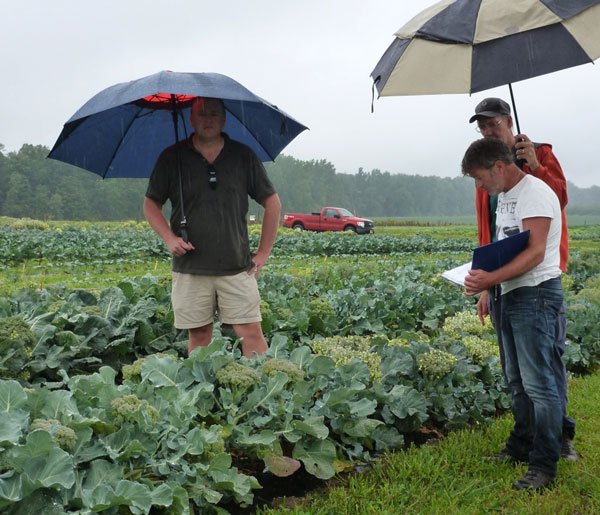At the Eden Valley twilight meeting, Christy Hoepting discussed variety performance with prospective growers in the new packing area of the W.D Henry and Sons. 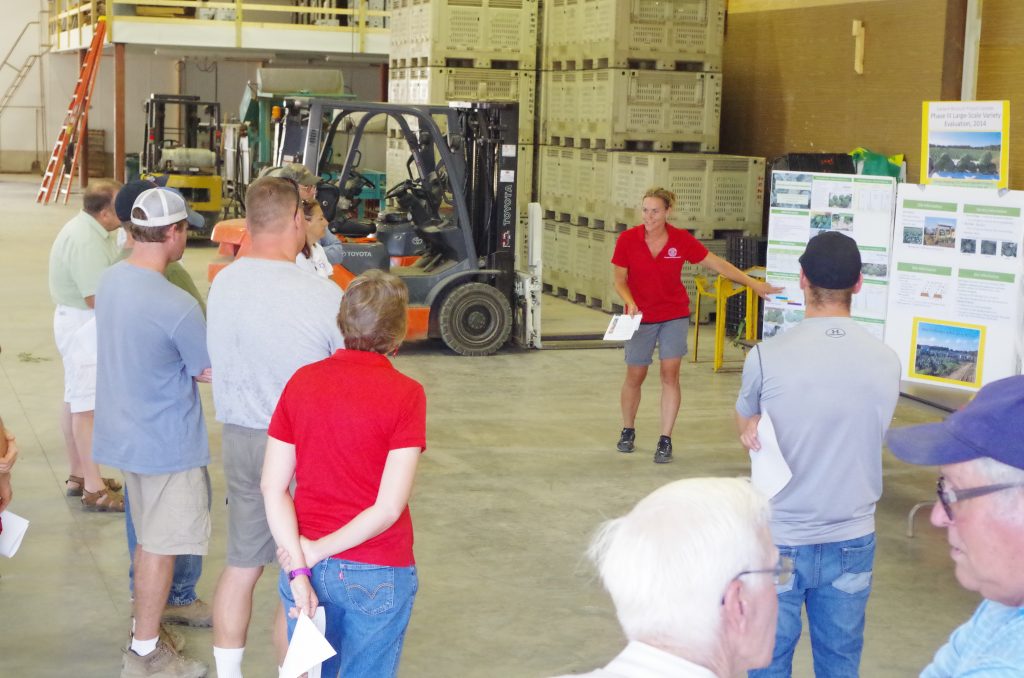
Later, in the field, the Phase III yield trial showed that the new varieties from the project were holding up well in the heat, where the older varieties were suffering.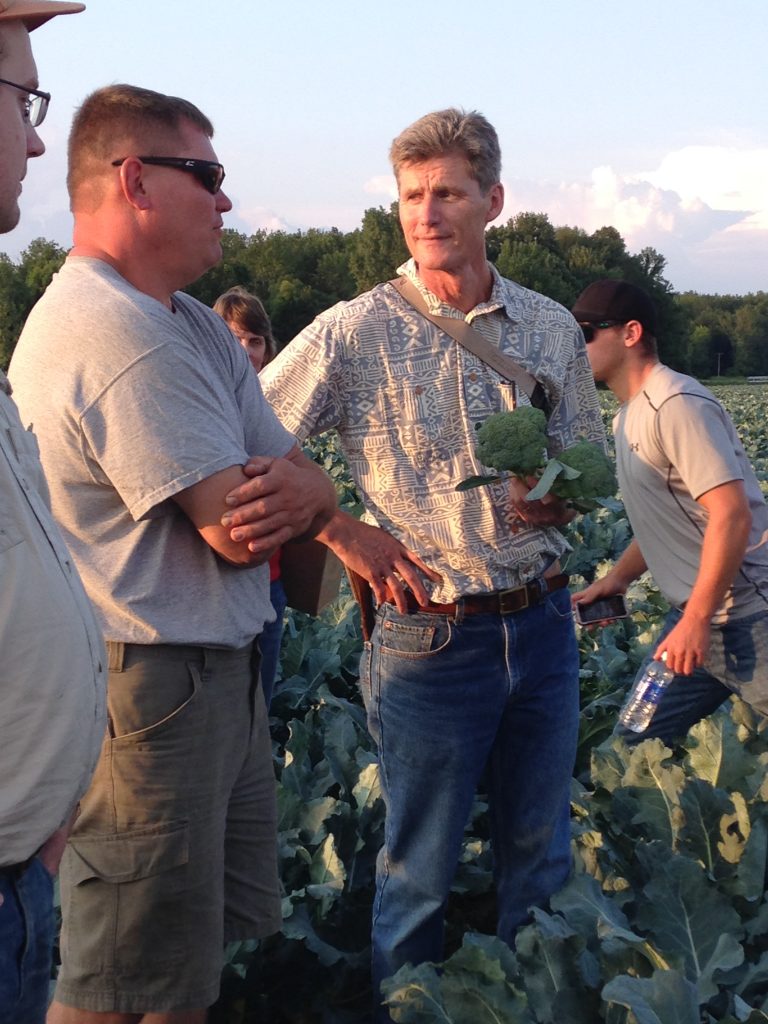
All posts by Thomas Björkman
Our collaborators at Johnny’s Selected Seed have a nice article on timing brassica planting. The article includes good examples of how different brassicas, including broccoli, modify their development in response to temperature. They mention Imperial as the most summer-tolerant in their line. In our trials, two varities that Johnny’s carries, Imperial and Bay Meadows, are standards that have been the ones to beat.
Produce Business on southern vegetable expansion
In the May issue of Produce Business, there is an article on the rapid growth in demand for locally grown vegetables in the southeast. That article is a special box about new varieties. the article highlights broccoli as a key vegetable that has been seeing an effort by regional growers. Powell Smith is quoted about adapting kale production to hot sandy soil, and also noting the sad fact that it has been a decade since Clemson had a vegetable breeding program. Our new collaborator, Tim Coolong at the University of Georgia outlines the many qualities required in varieties for them to thrive in the southeast.
The long search for May-harvested broccoli
A century ago, growers were also eager for broccoli varieties that could be harvested later into spring and early summer.
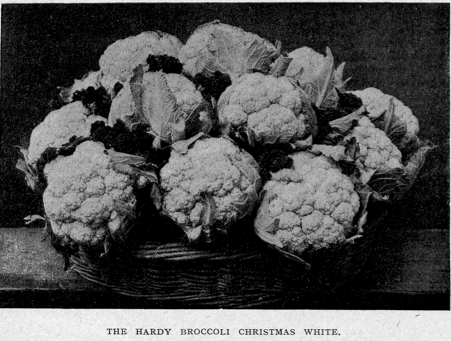
Some of the finest strains of late broccoli, however, are not in commerce, being in the hands of market-men, who have been selecting and re-selecting the stock for the last two or three generations, and from whom it is impossible to beg or buy even a single seed. In course of time, however, these will doubtless pass into the seeds men’s hands, when several late strains, later than anything at present in commerce, will be added to our list of useful varieties.
— F. W. Hammond. Pilgrim’s Hatch, Essex.
In The Garden, February 1917.
This article is about white broccoli, which was raised in England in the late 19th and early 20th century. It looked virtually identical to cauliflower but was cold hardy and raised for cold-season harvest. It was typically planted in the spring and harvested in either late fall or early the following spring. Biennial types headed and were harvested in the spring, but had little heat tolerance. Growers eagerly wanted late varieties that could be harvested in May and still look good.
Gómez in London to talk about expanding locally grown
The Perishable Pundit highlights Miguel Gómez’ upcoming presentation at the London Produce Show. PP Jim Prevor summarizes it as The Renaissance Of The Wholesale Sector — Why Those Who Support ‘Locally Grown’ Should Support Investment In Market Intermediaries.
The wholesale produce trade that is present at the New York and London Produce Shows is keenly interested in the economic results coming out of the Eastern Broccoli Project. Prevor writes “[Gómez] has been a superstar in New York, informing, educating and beguiling industry members.”
Miguel will explore the dilemma faced by farmers who are serving their local consumers through farmers markets and CSAs.
The goal is to connect local food systems to the mainstream distribution system. Markets where consumers buy directly from farmers are very limited in terms of volume, availability, and in terms of sustained economic viability for the farmer, who lives only out of these markets.
Margins are very thin, and the markets are easily inundated with excess supply. So the markets are restricted on the amount of farmers that can participate in going direct to consumers.
The concept does not fit the normal narrative for either the farmers market community nor the supermarket community. Therefore, bringing change that benefits consumers, small farmers, and supermarkets will take transdisciplinary assistance of the kind we have been developing in the Eastern Broccoli Project.
Value of local broccoli published
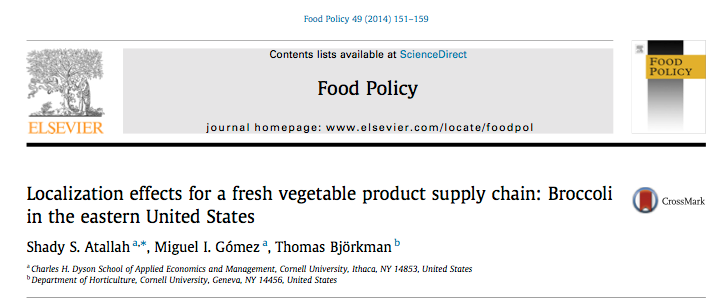 We have a new publication, “Localization effects for a fresh vegetable product supply chain: Broccoli in the eastern United States”. This article models how increasing the Eastern broccoli supply will reduce the overall cost of producing broccoli for the US market, and reduces the carbon footprint as well. The predicted flows of product among different Eastern markets is surprisingly complex.
We have a new publication, “Localization effects for a fresh vegetable product supply chain: Broccoli in the eastern United States”. This article models how increasing the Eastern broccoli supply will reduce the overall cost of producing broccoli for the US market, and reduces the carbon footprint as well. The predicted flows of product among different Eastern markets is surprisingly complex.
This research was part of the doctoral project of Shadi Attalah, who was a graduate student with Miguel Gómez at the Dyson School of Applied Economics and Management at Cornell. Shadi is now an assistant professor at Purdue University.
http://authors.elsevier.com/a/1PZUB15oGokQmh
This link will provide you with free access to the article through October 9, 2014. After that the cost to access the article is substantial. If the large-scale economic effects of locally grown produce is of interest to you, please take a look.
Shady S. Atallah, S., M.I. Gómez and T. Björkman. 2014. Localization effects for a fresh vegetable product supply chain: Broccoli in the eastern United States. Food Policy 49:151–159. DOI: 10.1016/j.foodpol.2014.07.005
The Alpha Vegetable
The New York Times ran a long Magazine piece about doing an image makeover for broccoli. The goal was to have broccoli be a “cool” food among younger people who don’t care about broccoli at all. Author Michael Moss brought out some important points about the relationship people have with vegetables, as well as the challenges of growing more vegetables in the current economic environment. Our project was mentioned as important, but a drop in the bucket towards that goal.

What do Eastern consumers want?
Prof. Miguel Gómez, team member in the Dyson School of Applied economics is determining what qualities Eastern consumers look for in their broccoli, and what variation from the Western standard they accept. The results will inform the breeding process, and perhaps identify types that will be well accepted in the US East Coast that are not accepted in East Asia.
With graduate student Xiaoli Fan, he is running auctions of broccoli types to asses consumer’s relative willingness to pay for different appearances.

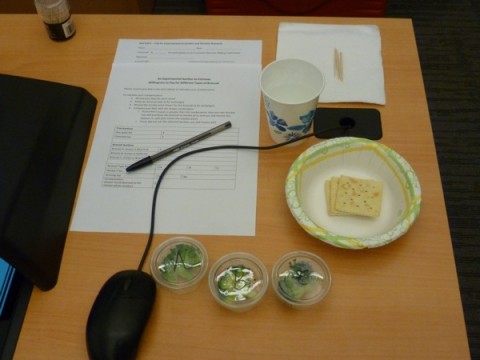

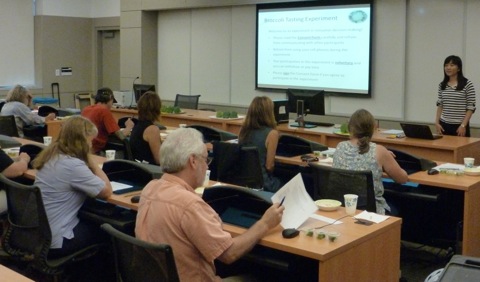
Commercial breeder visits
The commercial breeders on the project are inspecting trials this late summer, while the differences in quality are most apparent. Brassica breeder Cees Sintinie of Bejo (right front) stopped in Geneva as part of his North American tour. He was accompanied by his colleague Jan van der Heide (rear) when he visited with Phillip Griffiths (left). Characteristic of this summer, the rain was pouring. But rain does not slow this group.
Making seeds for Regional Trials
The regional trials require a lot of seeds of the new varieties. These are made by hand pollinating one flower at a time. This week, Griff’s group is finishing some hybrid seed for use in 2014.
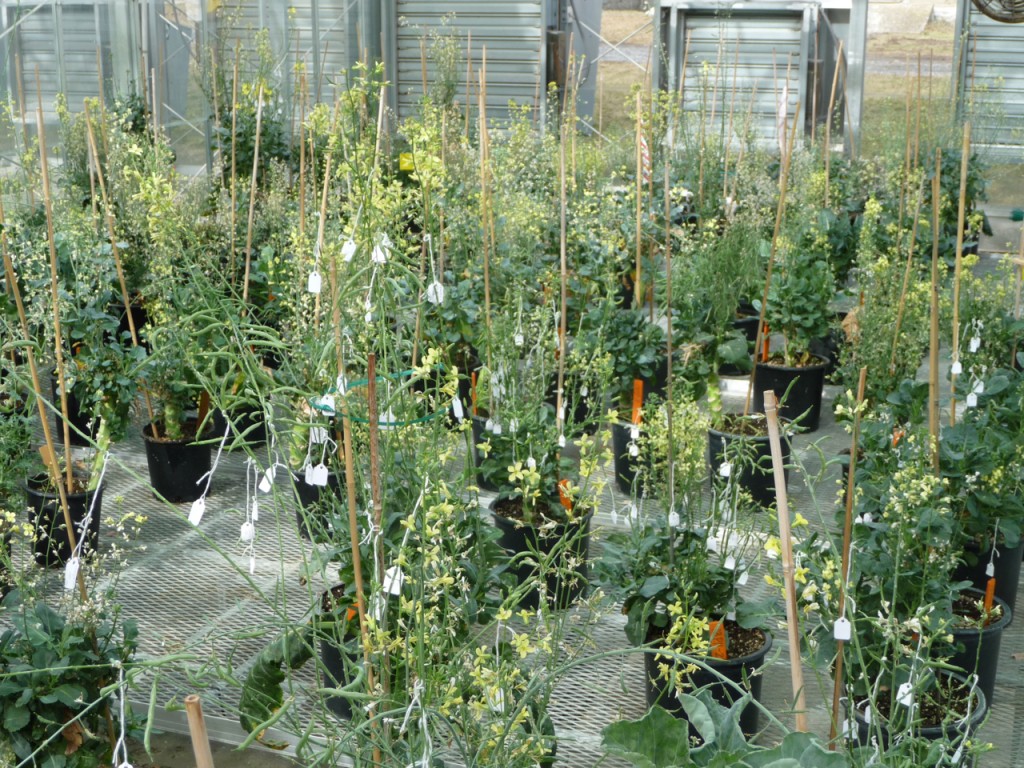

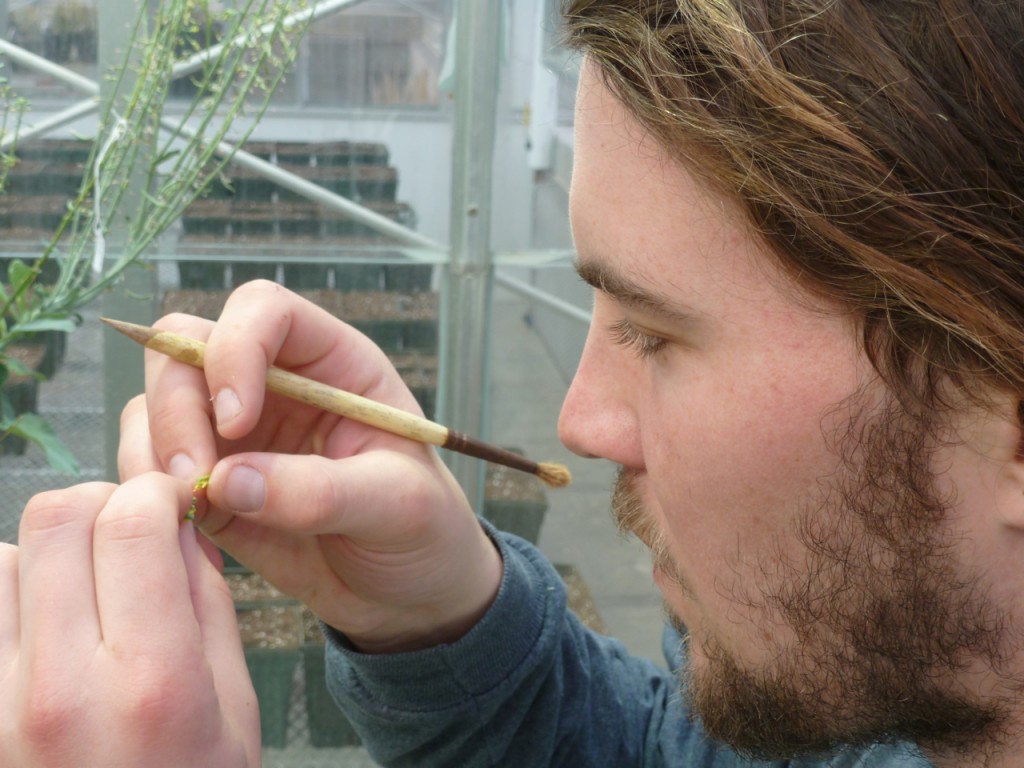
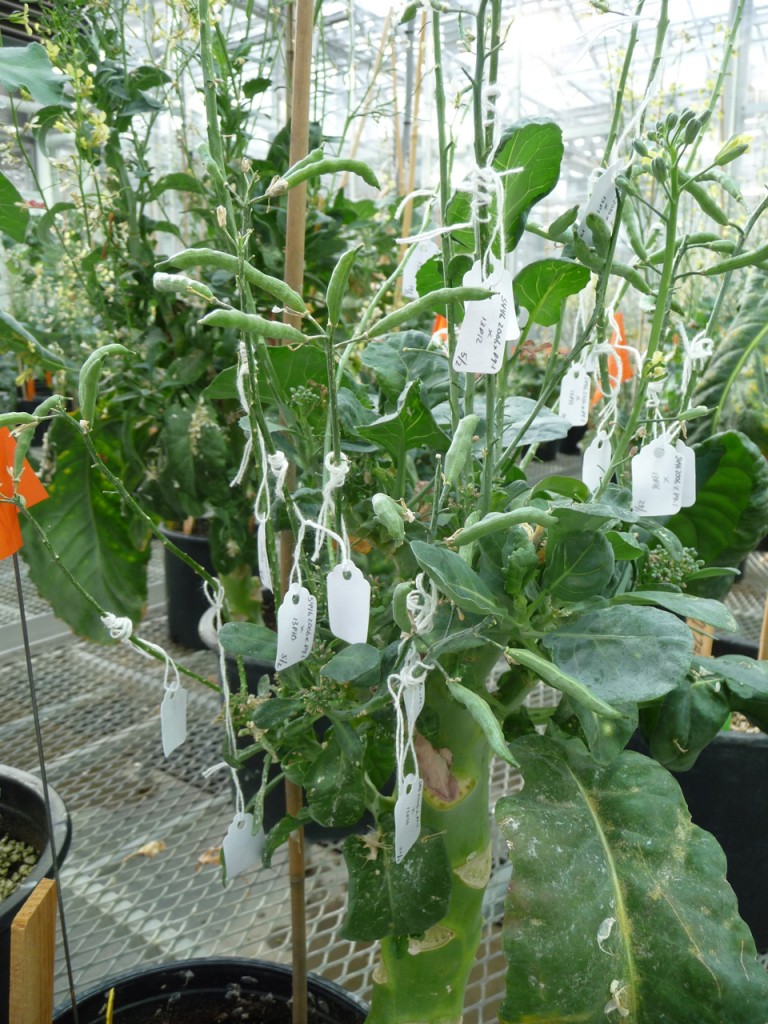
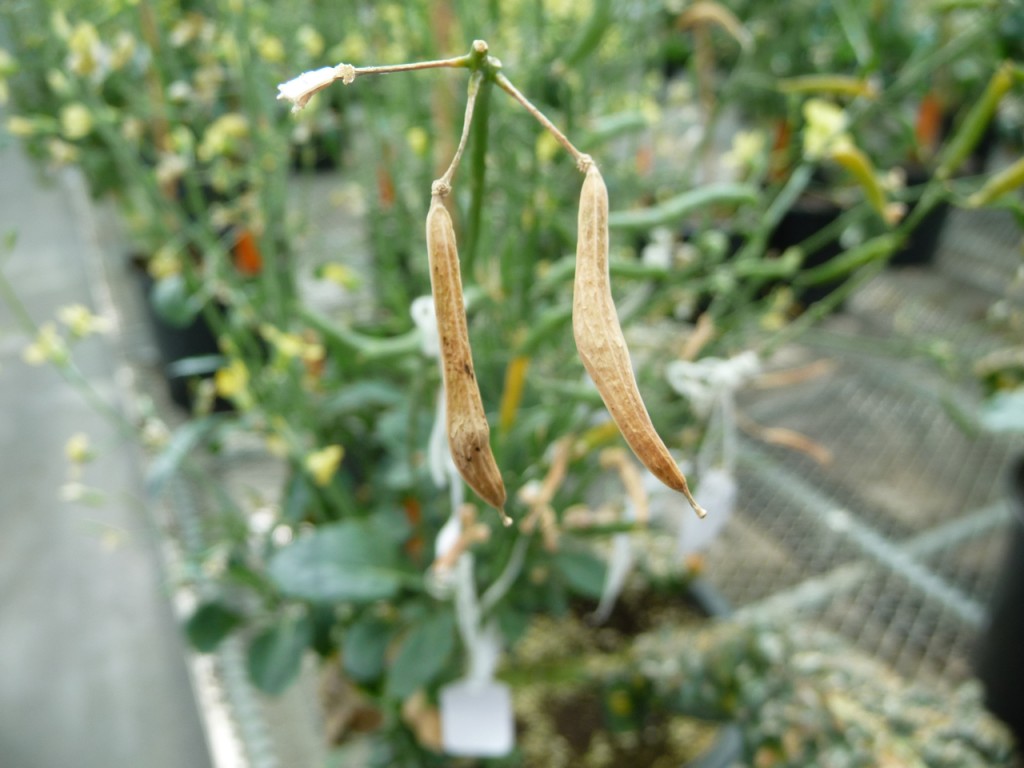
Some crosses result in few seeds. These fruits only have one seed each.

